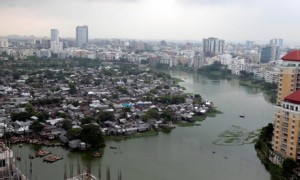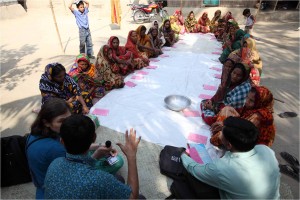
Since launching its first urban program in Dhaka in 1992, BRAC has established its flagship programs including health, education and microfinance in most major cities and towns in Bangladesh, including all of the ‘city corporations’ and most of the ‘pouroshobhas’ (peri-urban areas). Manoshi, BRAC’s maternal and neo-natal child healthcare program, reaches about 6 million slum dwellers. BRAC’s education program runs about 4,000 primary schools and its microfinance program reaches 60,000 borrowers in Dhaka city alone.
While it has demonstrated significant achievement in its engagement with urban communities, there is a feeling that BRAC has not had the sort of transformational impact that it had in the more rural parts of the country. There is an organization-wide agreement that the complexities and unique challenges of working in the urban space warrant more than simply adapting BRAC’s rural model. And as part of its efforts to frame the development of an organization-wide urban strategy, BRAC organized a three day long event in April that brought together a group of national and global experts on urban issues along with BRAC senior executives. Some of the major takeaways from the event are described below.
Understanding the urban context
The perspective of Bangladesh set into two worlds- rural and urban is no longer valid. And the notion of an urban-rural continuum, which shows links in practice, skill and experience (between rural and urban programming) resonated quite strongly over the course of the discussion. There is not just a Dhaka city or a remote village but all sorts of realities in between. Even people living in villages now have urban aspirations. So, there is an urban-rural continuum that BRAC will need to address. The urban space is not just “villages in a crowd”. BRAC cannot treat it the same way as rural although it may be doing similar things.
Neither local government nor urban civil society is responding appropriately. There needs to be more research because no one understands precisely what is happening to the urban space and the way it is changing.
Unique challenges
In the rural areas, when a household tries to improve its situation its social and economic indicators move in tandem. Economic gains also bring social gains. But it is different in the urban areas. The urban poor are making economic gains but social poverty is much more entrenched. This means that unlike the rural poor, in the social frontier, the urban poor are much worse off.
Urban poverty cannot be separated from urban governance – something that came up on numerous occasions. The way poverty in constructed, mediated and maintained in urban contexts is intrinsically linked to the complexities of urban power and politics. There are many dimensions of urban governance but mis-governance is a key issue that plagues them all. Access to land, housing and efficient yet affordable transportation are the most important to the urban poor. Centralized control of resources and a lack of power and decision-making ability are key impairments to local governments.
There is also very little discussion and understanding about what the urban poor want – why do they come to cities and what do they experience once they get there? In an informal setting where people do not have citizenship rights or cannot exercise them, we see that access to resources is established not through the rule of law but via contacts. Vested interests, mastaans and others create an impenetrable and very expensive grid of power through which the poorest have to navigate to access the services they need.
New paradigms and entry points
The most important task for BRAC will be shifting the focus from what it does and prioritize thinking about what it causes to happen. In the contexts of dealing with diversity, inclusivity, coverage, scaling up, and quality of impact; it is not what BRAC does but what it causes to happen that will be of critical importance.
Social mobilization had been the key to BRAC’s rural work using a Freirean approach. But to date, its urban program has had a lot of ‘hard’ services (delivery centers, schools, financial services, etc.) and much less ‘organizing and empowerment’. And over the decades since BRAC was established, a paradigm shift in empowerment has taken place; from a more ‘welfarist’ approach to a more agency based approach.
Traditionally social capital was talked about in a Freirean way; about bonding social capital and about building it through for like BRAC does with its ‘village organizations’ (VOs). But in an informal setting where people do not have citizenship rights or cannot exercise them, access to resources is established not through the rule of law but by contacts. And what BRAC’s Manoshi program does and what an increasing amount of new research is talking about is the need for ‘linking’ social capital. Ways to build ties across hierarchical or unequal relationships that enable people to traverse these differences in power, resources and status.
So, for the urban setting BRAC needs to think differently about the way services actually relate to organizing and empowerment. It also needs to think differently about how they relate to each other. The BRAC urban platform perhaps needs to think differently about integrating service delivery and empowerment. They are often viewed separately, but service delivery itself can be a path for social transformation.
Ideas for BRAC’s future urban work
When BRAC thinks about slums, they cannot only be the slums of Dhaka City. There are tier two cities, secondary towns and rural towns. All three types will require attention if BRAC wants to address the urban challenge. The package of interventions will have to differ in each case.
People centricity will need to be prioritized to an even greater extent in BRAC’s programming. Not just by focusing on a certain group because they are labeled as poor but in a realistic way by focusing on every citizen living in the urban space. Following through with the concept of viewing things as a continuum, BRAC will need to subscribe to the idea of a city that is inclusive.

Finally, if BRAC is to empower people to take power over their own lives in the urban setting then it requires a large paradigm shift and the development of a new strategy. The right people need to be engaged innovatively and effectively at each stage of all interventions. It means for BRAC to consciously restrict itself to a purely facilitating and enabling role. To work through partnerships; deepening ties with traditional partners (like clients and community members, academics, think tanks, other NGOs and development partners) and forming entirely new ones with people and groups that BRAC has relatively little experience with (like city corporations, trade unions and political parties). One cannot help but notice that even in the slums of Dhaka BRAC’s community groups are called “village organizations!”
Ishtiaque Husain works with the BRAC Social Innovation Lab.